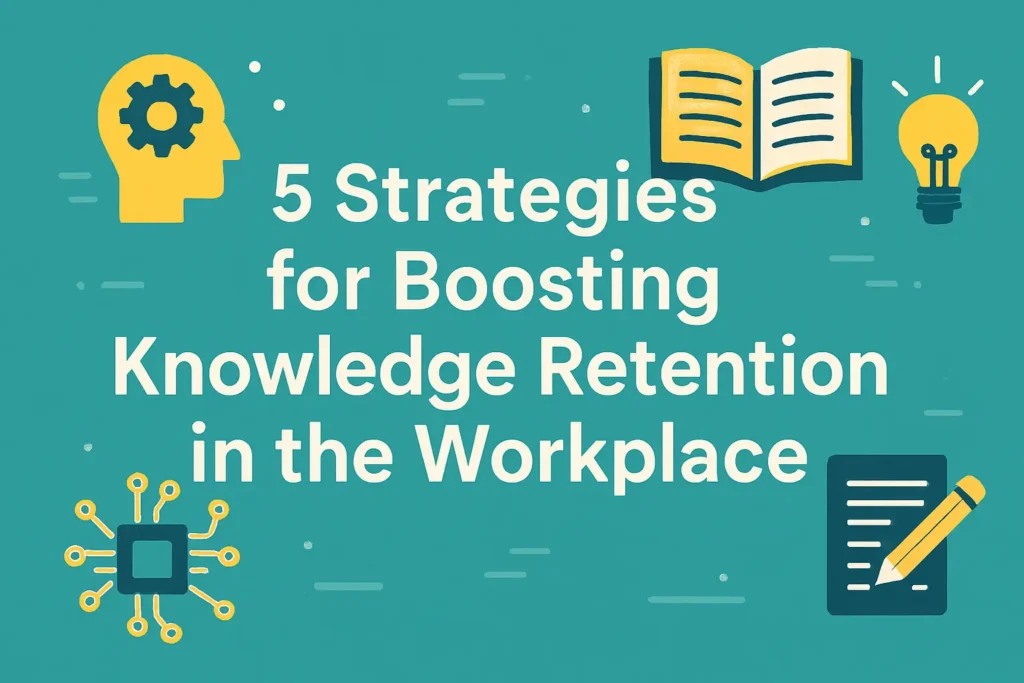The modern workplace is a dynamic ecosystem where knowledge is constantly being created, shared, and, unfortunately, sometimes lost. With employee turnover, retirement, and the natural ebb and flow of projects, organizations face a significant challenge: how to effectively capture and retain the valuable knowledge held within their workforce. This isn’t just about preserving information; it’s about safeguarding expertise, maintaining efficiency, and fostering continuous growth. Failing to prioritize knowledge retention can lead to duplicated efforts, costly mistakes, and a diminished competitive edge. Fortunately, there are proactive strategies that businesses can implement to combat this knowledge drain. Here are five key approaches to boost knowledge retention in your workplace:

Knowledge Retention in the Workplace
1. Foster a Culture of Knowledge Sharing:
At its core, knowledge retention is intrinsically linked to a culture that actively encourages and rewards knowledge sharing. When employees feel comfortable and motivated to share their expertise, insights, and lessons learned, that knowledge becomes more readily accessible and less likely to be lost when individuals move on. This can be achieved through various initiatives:
- Implement regular knowledge-sharing sessions: These could be formal presentations, informal lunch-and-learns, or dedicated time for team members to share project updates and key learnings.
- Encourage cross-functional collaboration: Breaking down silos and facilitating interaction between different teams allows for a broader exchange of knowledge and perspectives.
- Recognize and reward knowledge sharing: Publicly acknowledge employees who actively contribute to knowledge sharing through internal communications, team meetings, or even formal reward programs.
- Lead by example: Managers and leaders should actively participate in knowledge-sharing activities, demonstrating its importance to the rest of the organization.
2. Implement Robust Knowledge Management Systems and Tools:
Having the right infrastructure in place is crucial for capturing, organizing, and retrieving knowledge effectively. A well-designed Knowledge Management System (KMS) can serve as a central repository for valuable information, making it easily accessible to employees when they need it. Consider implementing:
- Centralized knowledge bases or wikis: These platforms allow for the documentation of processes, best practices, FAQs, and project learnings in a structured and searchable format.
- Collaboration platforms: Tools like shared document libraries, project management software with knowledge repositories, and internal communication channels facilitate real-time knowledge sharing and discussion.
- Video recording and transcription tools: Capture presentations, training sessions, and expert insights in video format with accompanying transcripts for easy reference and future learning.
- AI-powered search and recommendation engines: These technologies can help employees quickly find the information they need within the KMS, enhancing its usability and encouraging its adoption.
3. Prioritize Effective Onboarding and Offboarding Processes:
The transitions of employees joining and leaving an organization present critical opportunities for knowledge transfer and retention.
- Onboarding: Implement a structured onboarding program that includes not only basic training but also opportunities for new hires to learn from experienced colleagues, understand key processes, and access relevant knowledge resources. Pair new employees with mentors or buddies who can share institutional knowledge and best practices.
- Offboarding: When an employee decides to leave, conduct thorough exit interviews that specifically focus on capturing their knowledge and insights. Create checklists for knowledge transfer, ensuring that critical documents are updated, processes are documented, and key responsibilities are effectively transitioned to their successor or other team members. Consider having departing employees create “how-to” guides or training materials for their key tasks.
4. Leverage Mentoring and Peer-to-Peer Learning:
Tacit knowledge, the kind of expertise gained through experience and often difficult to articulate, is a vital asset. Mentoring programs and peer-to-peer learning initiatives can be highly effective in transferring this type of knowledge:
- Formal mentoring programs: Pair experienced employees with less experienced ones for guidance, support, and knowledge sharing. This fosters a strong sense of connection and facilitates the transfer of valuable skills and insights.
- Job shadowing and cross-training: Allow employees to shadow colleagues in different roles or participate in cross-training activities to gain exposure to different areas of the business and acquire new skills and knowledge.
- Facilitate peer-to-peer knowledge exchange: Create opportunities for employees with similar roles or responsibilities to connect and share best practices, challenges, and solutions. This can be through regular team meetings, dedicated forums, or informal networking events.
5. Encourage Documentation and Knowledge Capture as a Habit:
Making documentation a routine part of the workflow is essential for consistent knowledge retention. This requires embedding knowledge capture into daily tasks and providing employees with the necessary tools and training:
- Integrate documentation into project workflows: Encourage teams to document key decisions, processes, lessons learned, and best practices throughout the lifecycle of a project.
- Provide templates and guidelines for documentation: Make it easier for employees to create consistent and high-quality documentation by providing them with clear templates and guidelines.
- Allocate time for documentation: Recognize that documentation takes time and effort, and ensure that employees have sufficient time allocated within their schedules to properly document their work.
- Make documentation easily accessible and searchable: Ensure that the KMS is user-friendly and that employees can easily find and utilize the documented knowledge. Regularly review and update documentation to ensure its accuracy and relevance.
Prioritizing knowledge retention isn’t just about preventing loss; it’s about fostering a culture of continuous learning, driving innovation, and securing a sustainable future for the business.
